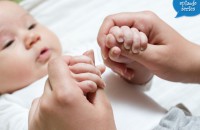The Boob Group
Breastfeeding Challenges: Mastitis, Galactoceles and MRSA
[00:00:00]
Please be advised, this transcription was performed from a company independent of New Mommy Media, LLC. As such, translation was required which may alter the accuracy of the transcription.
[Theme Music]
SUNNY GAULT: This episode of The Boob Group is brought to you by RuminaNursingwear. Hands-free pumping and nursing tanks and bras to support your breastfeeding goals. Visit www.pumpandnurse.com and save 20% with promo code BOOBGROUP20.
VICKI WOLFRUM: If your breasts are swollen, red and tender, and you have a fever or feel like you have been run over by a truck, you may have a common infection called mastitis. What are the symptoms and how do you get rid of mastitis? Is it still safe to breastfeed? If it’s not mastitis, then what is this painful lump? I’m Vicki Wolfrum, IBCLC, owner and senior lactation consultant at Whole Life Homecare at San Diego. Today, we’re talking about how to recognize a breast infection and how to treat it. This is The Boob Group.
[Theme Music/Intro]
LEILANI WILDE:Welcome to The Boob Group, broadcasting from the Birth Education Center of San Diego. The Boob Group is your weekly, online, on the go support group for all things related to breastfeeding. I'm your host, Leilani Wilde, I'm also an IBCLC and owner of Leilani’s Lactation and Doula Services. A special thanks to everyone who is listening to this episode on The Boob Group app. It’s a great way to listen on the go, visit our website at newmommymedia.com for more information. That’s also where you can sign up for our newsletter and learn more about fun ways to get involved with our show. Now Sunny is going to tell us more about our Virtual Panelist program.
SUNNY GAULT: Okay, hi everybody! If you aren’t here in beautiful San Diego where we record our episodes, we would still love for you to participate in the conversation. I am on Facebook right now, I am on Twitter and as we continue today’s conversation I'm going to be posting some questions that we’re talking about here in the studio. It’s a great way for you guys to hop on either Facebook or Twitter, see what we’re talking about, share your own experiences. I usually post some stuff about a week before we record as well, so keep a lookout for that. Look for hashtag #BoobGroupVP, VP stands for Virtual Panelist, to participate in the conversation.
LEILANI WILDE: Let’s introduce some of the people here with us today. Vicki?
VICKI LARSON: Hello, my name is Vicki Larson, I’m 37 I believe. I am an esthetician and owner of a business. I have one boy, he is nine months and he is quite the little white whale on the go. Anyone is familiar with baby beluga.
VICKI WOLFRUM: Should we start singing? I remember that song.
LEILANI WILDE: We’re here also with Vicki.
VICKI WOLFRUM: Yeah, I'm Vicki Wolfrum, and in addition to being an IBCLC I am also a mother of five children, and a grandmother of nine. It had been probably more than 20 years since I've had mastitis, but you never forget it once you have it. I definitely remember that, it’s something I deal with all the time, with taking care of moms and feel really passionate about helping moms avoid.
LEILANI WILDE: Yes, absolutely.
SUNNY GAULT: I'm Sunny, I’m producing today’s show and I’m the mother of four children, all of which, I can still say this for another month, all of which are ages 4 and under. Pretty soon my 4 year old is going to turn five and I'm not going to be able to say that. I breastfed all of them. My twins are really my success story, I've got two older boys, a four year old, a three year old and my twins who are now about 18 months.
As far as breastfeeding is concerned, it had some trouble with both my boys. I didn't breastfeed them for as long as I wanted to. I was still able to do it without much complication, but my girls now are going on 19 months and I'm still breastfeeding both of them, so they're my two success stories. I did have not quite mastitis, I will share my story probably a little later in the show, but I did have some discomfort at some point and you don’t forget that.
[Theme Music]
SUNNY GAULT: Before we get started with today’s show, we’re going to review a fun app that’s actually really helpful for breastfeeding and pumping moms out there. This just came out last month, it’s called Moms Pump Here. It’s available on iTunes and Android, and it is free, which is part of the fun that I have in finding these great apps that are free.
This was inspired by a breastfeeding and pumping mom who was having a hard time when she was out and about, finding locations where she could feed her baby. It basically uses GPS technology to determine where you're at, and it pairs that with nearby spaces at businesses, different locations where you can feed your baby.
Another great thing about this is that users can submit spaces or places where they have pumped or breastfed before, so if you're looking at your list and your like “Oh I don't know,” because a lot of places right now, since this is such a new app are kind of big spots, like the shopping malls you would think might have a location, or an airport or something like that. We know there's a lot of good locations to do that, it’s just informing other moms about these locations.
You can submit your own spaces, and it will have the availability too, if you want to comment on a space, how well it worked out for you, something that’s already been listed. They do have a group of people that are vetting these user submitted sites, so if you submit something it’s not going to be posted right that second, because people have to go in and make sure that it’s a location that’s appropriate to share with everybody.
But yes, it shows how many miles it would take you to get to that location, some photos and stuff, so like I said, brand new app that just came out, but I can really see the potential with it. I want to talk to you ladies about it, is this something you would recommend, perhaps to some of your clients, is it something you would use personally? Our panelists, Vicki, what do you think?
VICKI LARSON: I think it’s actually a really great idea, I wish I had something like that while I was breastfeeding, because there were many times when I probably had to go to my car to pump if my child wasn’t with me, or have to try to find a discreet location to breastfeed. Definitely I think it is an excellent app, and it will help many moms that are in a pickle.
SUNNY GAULT: Yes. Our IBCLCs in the room, is this something that you would recommend to clients? Leilani?
LEILANI WILDE: Yes actually, I think it’s a great idea. What better options are available for us out there? A lot of moms feel like they're stuck at home and can't get out, because they don’t want to breastfeed in public or they don’t know how to pump in public. I have even seen moms pump while they're driving, so people are pretty desperate and they’ll do whatever they can. Having that option and knowing where to go, even the directions, it’s pretty cool. The GPS, yay. What do you think, Vicki?
VICKI WOLFRUM: Yeah I think it’s great, I do believe that it will really help to normalize breastfeeding and pumping, and the more sites that there are available it'll be a huge benefit to moms.
SUNNY GAULT: Okay! Well, like I said it’s available on Android as well as iPhone and iPad. It is free so we will put a link on our website so you guys can check it out from there.
[Theme Music]
LEILANI WILDE: Today on The Boob Group we’re launching a new series on the show, focused on common breastfeeding challenges. Today, we’re exploring mastitis with our expert, Vicki Wolfrum, an IBCLC and owner of Home Life Homecare in San Diego. Welcome Vicki!
VICKI WOLFRUM: Thank you.
LEILANI WILDE: What is mastitis, and what are the symptoms?
VICKI WOLFRUM: Mastitis is medical terminology for a breast infection that occurs during breastfeeding, and there are 3 main causes of breast infections. The first one underlies all mastitis, and that is sleep deprived, immune depleted, exhausted mothers. When mothers are trying to do too much and when they're not getting enough rest, not eating enough healthy food, not staying well hydrated, they're susceptible to developing a breast infection.
Every day that your sweet little baby is on the breast, sucking away, there is an entryway for pathogens, for bacteria and really the most common bacteria that causes mastitis are bacteria either on the mother’s skin, the baby’s skin or the baby’s mouth. They're pretty common bacteria, and when they're allowed to get into the breast, especially when the mom’s immune system is depleted and not able to fight off the infection, that’s when it starts.
Contributing to that are two other things that are pretty common in new moms, and that is cracked, damaged, abraded sore nipples, because of course not only does that allow more entry of the bacteria into the breast, but it kind of creates a little collection pool where bacteria can hide and congregate on the nipple.
LEILANI WILDE: Have a party.
VICKI WOLFRUM: Have a party, yes. When a mom is exhausted, as most moms are in the first couple weeks of breastfeeding, and she has a crack or opening on her nipple, that just gives the bacteria the opportunity to get into the breast and cause an infection. The other one is a plugged duct, and a plugged duct simply means that somewhere along the pathway form the back of the breast where the milk making cells are, to the nipple where the milk is expressed, that there's some type of blockage.
A lot of times this is due to the fact that maybe the breast didn't get emptied completely, and some milk just sat in there and congealed. Once that milk sits in there and congeals, the milk behind it creates a pool and f there's some bacteria that snuck into the breast, it gives the breast infection an opportunity to start.
Most moms’ first symptom of a breast infection is a very painful, sore lump on their breast. It can be scary, because any time there's a lump in the breast we’re nervous about it, even when breastfeeding, although they're pretty common during that time. The difference with this type of a lump is that the breast can become very red, hot to the touch and swollen. Pretty quickly the mom herself starts to feel sick, she feels like she has a terrible flu.
She feels achy, she feels chill, she fills fever and sometimes the fever can go up quite high. Sometimes 103, that type of thing, and the breast is so painful, the last thing the mom wants to think about doing is putting the baby to breast, but that’s exactly what she needs to do.
LEILANI WILDE: It comes on pretty suddenly.
VICKI WOLFRUM: It does. A lot of times if you are in that situation, there's a variety of different natural things you can try to ward off the breast infection. The other Vicki here, she was just saying how she was able to do that. Usually if you kind of nip it in the bud and your temperature goes down in the first 24 hours, you don’t need to take any antibiotics. If the breast infection persists and the fever continues into the second day, it’s probably advisable for most women to take antibiotics, even though we don’t want to put moms on antibiotics during breastfeeding if we don’t have to, it is very important sometimes because we don’t want an abscess to form.
LEILANI WILDE: Is it still safe to breastfeed when you have mastitis?
VICKI WOLFRUM: It is still safe, in fact it’s beneficial for your baby, because first of all if you had a breast infection and you didn't empty the breast, not only would it be harder to get rid of the infection, but the infection could get worse and lead to an abscess. The other thing is that when you're breastfeeding, again, it’s quite commonly bacteria that is on the skin surface of the breast, and it can also be bacteria that was in the baby’s mouth, so this is not some weird strange pathogenic bacteria that comes from the outside in general.
It is something really common, and your body, as you have this infection, is making antibodies against that particular bacteria. Those antibodies are going from the milk to the baby, and of course that is your baby’s best protection, to have the mother’s milk with the antibody component.
LEILANI WILDE: Right, because the baby has already been exposed to that bacteria, so it starts working either way.
VICKI WOLFRUM: There are times when moms, either because they're afraid of the baby getting infected milk, it creeps them out, they just don’t like the idea or because their breast is so painful, that to breastfeed the baby is more than they're willing to do. If that mom wants to continue breastfeeding, she still needs to empty that breast, so then she needs to pump that breast. Most of the time the pumping is still painful, but maybe not quite as much as a squirmy baby or a big baby that’s all over the place popping off and on, doing those cute little things that babies like to do.
LEILANI WILDE: Right. Vicki, have you ever been diagnosed with mastitis?
VICKI LARSON: I technically was not diagnosed with mastitis, but as the other Vicki was explaining I did have early onsets of mastitis. I started to feel very flu-ish, and temperatures started to go up. I love google, and I think that’s all new moms really do, sit on their phone and google. That, and Amazon Prime.
I looked to try and see if there were some common remedies that I could do, to kind of ward off any kind of infection, so I did a couple of things. I did raw garlic and OJ every 30 minutes, pretty much for eight hours. The fever never really went up past 99.9, it went down and the flu-ish symptoms subsided. I don’t believe I had full blown mastitis and I never had to get on antibiotics thankfully, but if it had progressed I would’ve gotten on. I figured this is a pretty easy and harmless option to try before I had to do the antibiotic route.
LEILANI WILDE: Besides the fever, what other symptoms did you experience?
VICKI LARSON: I woke up from a nap, and it was hot, painful, in my left breast. My son was having a hard time because he tore a callus, which is a kink in the neck, so he had a hard time draining it. as Vicki was saying, I didn't have much sleep so I wasn’t pumping as much as I probably should’ve been, in addition to breastfeeding him, so I believe that lack of sleep and lack of pumping, it just not getting drained led to that. In hindsight, I probably should’ve pumped a little more, but I was just like whatever.
LEILANI WILDE: But you jumped on it right away, which is great.
VICKI WOLFRUM: Actually you might have inadvertently done the right thing, because I think that’s one of the areas where we tend to get into trouble sometimes, it’s with pumping. So many new moms are already worrying from day one, knowing they have to go back to work, worrying about their milk supply.
LEILANI WILDE: Yes, definitely.
VICKI WOLFRUM: Mother Nature had this perfect plan, which was the baby came out, it went to the breast, stayed attached to the mother in proximity to the breast 24 hours a day for the first six months to a year, and just breastfed liberally all the time. If all of us could do that, it would be one thing but since modern women have to try to juggle so many different things, a lot of times people are pumping in that first month or two of life, when it can sometimes kind of create that issue of an irregular or overly large supply that the baby can't really empty the breast necessarily all the time, or leave the breast partially full. Sometimes pumping can actually contribute to mastitis.
VICKI LARSON: I don’t think I ever had an oversupply.
SUNNY GAULT: No, she was working on keeping her supply.
VICKI LARSON: Oh yes, just the little supply I had before the lump. I was definitely struggling, because he had a lip and a tongue tie.
VICKI WOLFRUM: Oh my goodness, and torticollis.
VICKI LARSON: And torticollis, and a 60 hour labor. We were starting out real great.
VICKI WOLFRUM:You’re exactly right, the torticollis just means when the baby is head down, in positon to come out, if he’s tilted a little to one side there may be a number of weeks that the baby is in the same position, and the muscles on the side of the baby’s neck tighten up.
So when you put your baby down, if your baby always looks to the left or right, you can start to be a little suspicious that that might be the case with your baby. You'll also know that the baby prefers one breast and prefers one position. If this is the case, sometimes you do have to be creative about getting the baby to empty both breasts. It sounds like you were well aware of that, so that’s great.
VICKI LARSON: I was, and I think it was that day that I got the massive, lemon sized lump. I remember specifically he went to the right, and I was so exhausted because he was a slow eater. Oh my gosh, this guy took forever, and I was like “Eh, we’ll just leave the left” and I took a nap and woke up. So I didn't even let him, because the left was so difficult to get him to latch on and stay latched and not be painful anyways. That was my problem breast for sure.
LEILANI WILDE: This proves our point of how quickly it can come on, in an hour or two of a nap.
VICKI WOLFRUM: You're kind of the perfect guest to have, because you have had a little b it of everything that contributes to mastitis, and that’s another thing. When the baby has lip and/or tongue tie, those babies have a hard time emptying the breast. They sometimes are very slow eaters. Just the way their mouth is on the nipple tends to cause nipple damage, and that contributes to it. That’s one of those late onset effects. Sometimes when babies with ties that don’t get addressed, just because the baby is getting enough milk and doing okay, sometimes later on those moms are predisposed to getting recurring mastitis, so you're kind of our poster child.
VICKI LARSON: Yay, lucky girl.
LEILANI WILDE: Vicki, were you still able to breastfeed after?
VICKI LARSON: I did. I could still breastfeed. I only breastfed until 3 months, partly because I had to go back to work and to keep up my supply, since it was so low to begin with I had to pretty much pump the entire time I was at work. Why be at work if I'm going to pump most of the time, so we just completely stopped.
LEILANI WILDE: During the infection that you...
VICKI LARSON: Yes, that definitely was encouraged.
LEILANI WILDE: But you also noticed a drop in your supply, right? I remember you mentioning that.
VICKI LARSON: Yes, it definitely dropped my supply but only because the lump was so big. I think it was just clogged. They're having a party in there, basically.
VICKI WOLFRUM: Yeah.
VICKI LARSON: Didn't feel like it.
LEILANI WILDE: Sunny, did you experience any of these things?
SUNNY GAULT: It wasn’t diagnosed as mastitis, but some of the symptoms that you guys were talking about are exactly what I experienced. It happened so quickly. I felt like in a matter of 30 minutes I went from being fine to feeling all those flu symptoms, I had red streaking on my breast, I think it was my right breast.
I called a friend of mine who was a lactation consultant and I said “What is going on?” I just never really had any major problems with breastfeeding before, so this was new to me even though it was with the twins and I had breastfed my boys prior. This was the first big thing that happened. I just felt very weak, exhausted and there was a vitamin that was recommended to me.
VICKI WOLFRUM: Vitamin D3.
SUNNY GAULT: Vitamin D3, so my husband ran out and got some. I never had to get any more medication past that, probably within a few hours I was starting to feel a bit better, but still I was kind of bedridden for most of that day. The next day it just slowly started to taper off. I continued to breastfeed my girls throughout the process, and oh my gosh it was one of the most painful things. Forget biting, this was just so painful, but I was advised to keep breastfeeding through it and that’s what I did.
LEILANI WILDE: Rest was a good thing.
SUNNY GAULT: It was a really hard thing to do with 4 kids in the house, but I said to my husband that I have to deal with this. If you want your children to be fed, let me deal with this. You take care of them right now.
LEILANI WILDE: It’s good to have the right support. Absolutely.
SUNNY GAULT: Absolutely.
LEILANI WILDE: When we come back, we’re going to learn more about Galactoceles and other infections, and then learn whether or not it is safe to still breastfeed while going through it. We will be right back.
[Theme Music]
SUNNY GAULT: Looking for all-in-one tanks and bras to help you easily transition from pump to baby? RuminaNursingwear’s Pump & Nurse collection is designed for your unique body, to support your breastfeeding goals and your busy new lifestyle. Simple, hands-free pumping with no additional straps, hooks or Velcro. Comfortable all day support for busy multitasking moms, and convenient full skin-to-skin nursing. Plus, Boob Group listeners save 20% with promo code BOOBGROUP20. RuminaNursingwear – Simple, comfortable and convenient. Visit their website at www.pumpandnurse.com and save today!
[Theme Music]
LEILANI WILDE: Welcome back to the show, we’re learning all about mastitis and other breast infections with Vicki Wolfrun. Vicki, what is a galactocele?
VICKI WOLFRUM: A galactocele is a milk-filled cyst that occurs in the breast of a woman who is lactating. It quite commonly occurs when someone is either weaning, or for some reason they're not able to breastfeed and they have a period of time that their breasts aren’t emptied. When the breasts aren't emptied, oftentimes the milk will clog up the tubing and when the tubing gets clogged up and the milk doesn’t come out, a lot of times behind that clog there forms a little pool of milk. That’s what a galactocele is.
Galactoceles are actually not that common, and when you're talking about mastitis, the more common thing that happens is that the mother actually forms the same type of scenario, but it’s an infected milk so it’s an abscess. That’s something that causes a great deal of pain and misery for moms who progress mastitis to an abscess.
If it’s just as in the case of Vicki, she had the beginning symptoms of mastitis, but was able to work through them with some of her natural remedies, and it didn't turn into a full-blown mastitis or abscess, but she did have an area in her breast that was filling up with milk and was ultrasound-able.
VICKI LARSON: Right.
VICKI WOLFRUM: Is that what happened?
VICKI LARSON: Yes, it wasn’t going away after a couple of weeks I believe. Leilani you came over, we even took my Sonicare toothbrush to kind of break it up. It was really painful to get him to latch on, but probably after week two the pain subsided but the mass was still there. What prompted me to get an ultrasound was that I was watching the news, and one of my old clients was actually on the news because she had been breastfeeding, and found what she thought was mastitis and a lump.
She went in to get antibiotics, and found out it was breast cancer and it was October. I started to freak out a little, because I thought “Why is this thing not gone? It’s so huge.” That’s when I requested to get an ultrasound, to double check and make sure it wasn’t anything besides what they were telling me it is.
Thankfully it was not any kind of tumor like breast cancer, but they diagnosed it as a galactocele. The pain went away but the lump was still there, and it wasn’t really going down, even with all the things was doing to try to get it to go down.
LEILANI WILDE: What did you end up using that helped?
VICKI LARSON: I found, again my friend Google came across a homeopathic website and silica, [inaudible], it’s just a mineral and they suggested to take I think four little pills. They just dissolve under the tongue. I took it 5-7 times a day for a while, and by probably the end of week 4 it started to break up and get smaller. I continued, and then by week 6, in my 8th week total from when he was born, it was gone, even though I was still breastfeeding.
LEILANI WILDE: Did you use anything else, like vibration, a massage or extra pumping, anything on top of the silica or was it just the silica that you felt like it helped?
VICKI LARSON: I did everything that I could. I went and got lymphatic drainage massage, I went and had therapeutic ultrasound, I had acupuncture, pretty much everything so who knows. It could’ve been a combination of all of those things, but the silica, again wasn’t anything that I knew would hurt him or myself, so I figured I’d try it. I couldn’t imagine having that lump in there for the remaining time of breastfeeding, it just got to be annoying after a while.
LEILANI WILDE: Did your baby prefer the other side, or was he still okay to breastfeed on that infected side?
VICKI LARSON: He was okay. Just our normal latching on issues, it was always such a challenge, an ordeal. Besides that, he was fine. He was working through, we were getting him cranial sacral for the torticollis and he had a really high pallet, so he couldn’t feel the nipple.
VICKI WOLFRUM: That’s just a lovely time.
LEILANI WILDE: Well experienced mama.
VICKI LARSON: Oh yes.
LEILANI WILDE: Vicki, what is MRSA? It’s a type of infection, is that correct?
VICKI WOLFRUM: Right, MRSA is Methicillin-resistant Staph aureus. The most common bacteria that causes breast infections are Staph aureus. It is a common skin bacteria. There's Staph epidermis and Staph aureus, they’re the two staphs that live on most people’s skin. In the past year, so many people have been given antibiotics, in particular antibiotics in the penicillin family and amoxicillin family that staph aureus developed a resistance in some cases, so this bacteria is particularly hard to get rid of.
It started out as a pathogen that was only in hospitals, but because it became so widespread, there is now both hospital-acquired and community-acquired MRSA. It’s just that one step above the other types of bacteria, because there are a lot of antibiotics that it just snubs its nose at basically.
So when moms have this type of breast infection, not only is it more difficult to treat, because the first line of defense for breast infections when they do give an antibiotic is usually dicloxacilin, but it is probably one of the more common pathogens that helps the breast infection turn into an abscess, which is a more serious infection in the breast.
It’s similar to the galactocele in that it’s a cystic mass in the breast that is very painful, but rather than being filled with just milk it is puss. Definitely not something you want to have when you're breastfeeding.
LEILANI WILDE: Is MRSA contagious? Should they worry about breastfeeding their baby?
VICKI WOLFRUM: It is very contagious, but they don’t really have to worry about breastfeeding because the baby has already been exposed to it. More than likely if the MRSA is at the point where it’s causing a breast infection, it’s been on the skin of the breast and the baby has already been ingesting it, touching it, rubbing his face in it.
The best protection the baby has to fight it is to get the mother’s breast milk that has antibodies against MRSA. Once again, even though to some moms it seems to be a horrifying idea that they would breastfeed their baby, it’s actually the best thing for them.
LEILANI WILDE: It’s actually more detrimental if they don’t, because then the baby will get sick or can get a MRSA infection.
VICKI WOLFRUM: It’s possible.
LEILANI WILDE: Thank you so much Vicki and Vicki for sharing this invaluable this invaluable information on how to recognize a breast infection like mastitis and galactoceles, and how you can still protect your breastfeeding relationship with your baby. For our Boob Group Club members, our conversation will continue after the end of this show as Vicki will discuss how you can treat mastitis and galactoceles with natural remedies, so that you can avoid antibiotics. For more information about our Boob Group Club, please visit our website at www.newmommymedia.com
[Theme Music]
SUNNY GAULT: Hey Boob Group, we have a special segment right now, this is called Mama Hacks, and it’s a new segment on the show where you guys share your favorite breastfeeding and pumping hacks, anything that makes your life a little more simple when you're feeding your babies.
This tip comes from Diane. Diane wrote to us on our Facebook page, she said “Something I learned from the La Leche League forums, while pumping 3 times a day at work I save time by sticking my milky pump parts in an opaque bag, into the fridge with my pumped milk and only washing them at night at home. Such a time saver!” Yes Diane, I actually did a little bit of research about this, and we already know that breast milk has amazing, wonderful antibacterial properties.
Really most people say you're not going to say any kind of significant bacterial growth after almost a full day at room temperature, but I get it, you're at work, you're probably not just going to leave something out in the open for everyone to see.
So smart, an opaque bag, no one can see anything. Go ahead and put it in there with your other milk, and if you really want to wipe it off with a towel or something like that really quick, I'm sure you can. If you don’t have a fridge you could use some sort of cooler pack, something like that. Huge time saver, so Diane, thank you so much for submitting your pumping hack to us!
For doing so, you're going to get a 1 month free subscription to The Boob Group Club, so we’ll be reaching out to you about that. If you mamas out there have a breastfeeding or pumping hack, some sort of information you just want to get out there to other mamas, please let us know. You can send us an email through our website, and you can also call our voicemail at 619-866-4775 and we will try to use your hack in an upcoming episode. Thanks so much!
[Theme Music]
LEILANI WILDE: That wraps up our show for today. We appreciate you listening to The Boob Group.
Don’t forget to check out our sister shows:
• Preggie Pals for expecting parents
• Parent Savers for moms and dads with newborns, infants and toddlers
• Twin Talks, for our show with parents of multiples.
Thanks for listening to The Boob Group: “Your judgement-free breastfeeding resource.”
[Disclaimer]
This has been a New Mommy Media production. Information and material contained in this episode are presented for educational purposes only. Statements and opinions expressed in this episode are not necessarily those of New Mommy Media and should not be considered facts. Though information in which areas are related to be accurate, it is not intended to replace or substitute for professional, Medical or advisor care and should not be used for diagnosing or treating health care problem or disease or prescribing any medications. If you have questions or concerns regarding your physical or mental health or the health of your baby, please seek assistance from a qualified health care provider.
SUNNY GAULT: New Mommy Media is expanding our line up of shows for new and expecting parents. If you have an idea for a new series or if you’re a business or organization interested in joining our network of shows through a co-branded podcast, visit www.NewMommyMedia.com .
[00:35:56]
[End of Audio]












